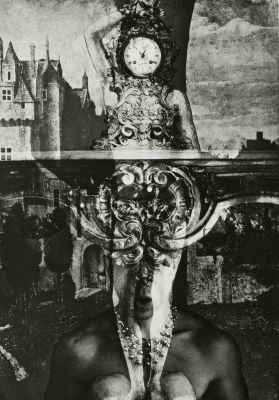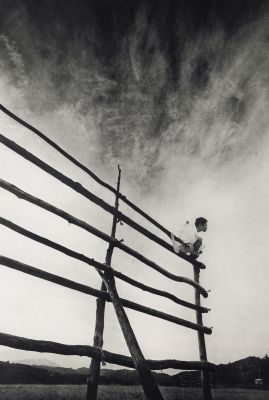
Title
Kamaitachi #36Artist
Hosoe, Eikoh (Japanese, b.1933)Publication
AwakeningsDate
2001 plate (1968 negative)Process
PhotogravureAtelier
Jon Goodman Photogravure, MassachusettsImage Size
18 x 12 inSheet Size
30 x 22 1/2 in
Original edition of 250 (only 25 printed). From a portfolio of 5 prints chosen from Eikoh Hosoe’s first photographic series: "Man and Woman," "Barakei," and "Kamaitachi." Baroque, theatrical, and rich with metaphor, Hosoe’s photographs evoke a dark, post-nuclear folklore of the Japanese imagination that is peopled by characters both real and fictitious. These five large photogravures printed by Jon Goodman for Aperture are accompanied by letter press text written by the photographer, are signed and numbered by Hosoe.
Eikoh Hosoe (b. 1933, Yonezawa, Yamagata, Japan) is an integral part of the history of modern Japanese photography. He emerged in the experimental art movement of post-World War II and is known for his high-contrasted photographs of human bodies and exploration of subjects including death, erotic obsession, and irrationality. Hosoe remains a driving force for his own work and his efforts as a teacher and ambassador, fostering artistic exchange between Japan and the rest of the world. Eikoh Hosoe is represented by Howard Greenberg Gallery, New York, and Michael Hoppen Gallery, New York. He currently lives in Tokyo, Japan.
For his striking series Kamaitachi (1965–68), Hosoe collaborated with Tatsumi Hijikata, one of the founders of the experimental dance form butoh. The work is linked to the photographer’s childhood memories of the war, when he was evacuated to the rural Tōhoku region. Hijikata, who grew up there, embodies the kamaitachi spirit of folklore said to haunt the rice fields. The dynamic scenes show the dancer running in the fields, dramatically jumping, hiding, or “stealing” a local farmer’s baby, and they also often mirror Hosoe’s own physical involvement, taking photographs while running or from unusual vantage points. Even today, elderly people in the village remember the photoshoots.



